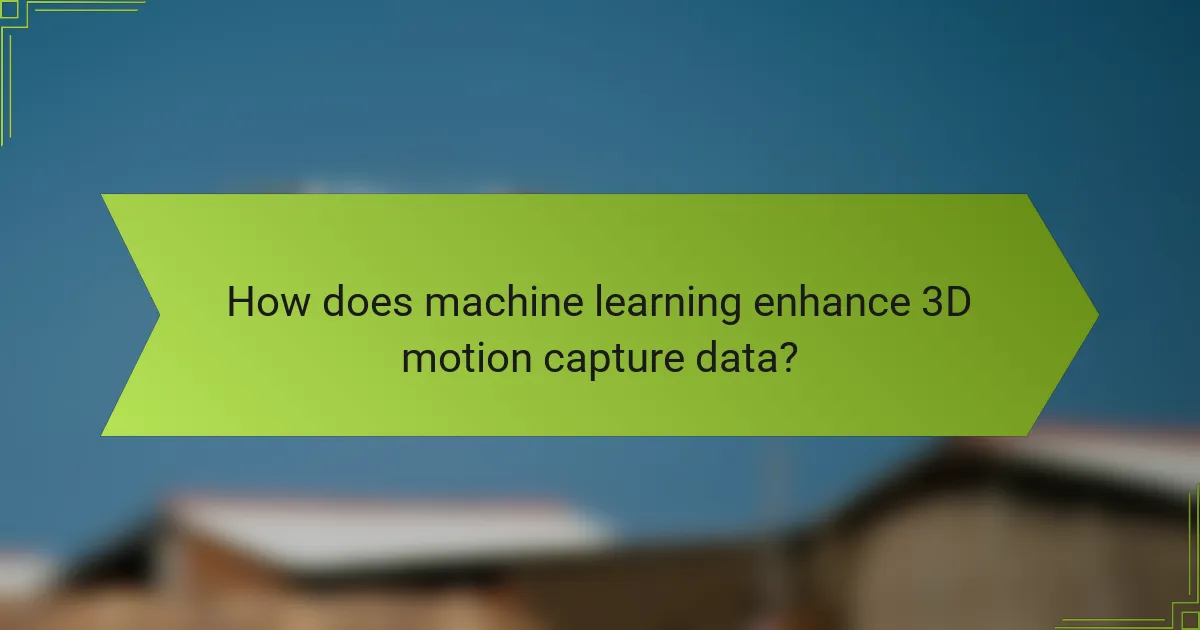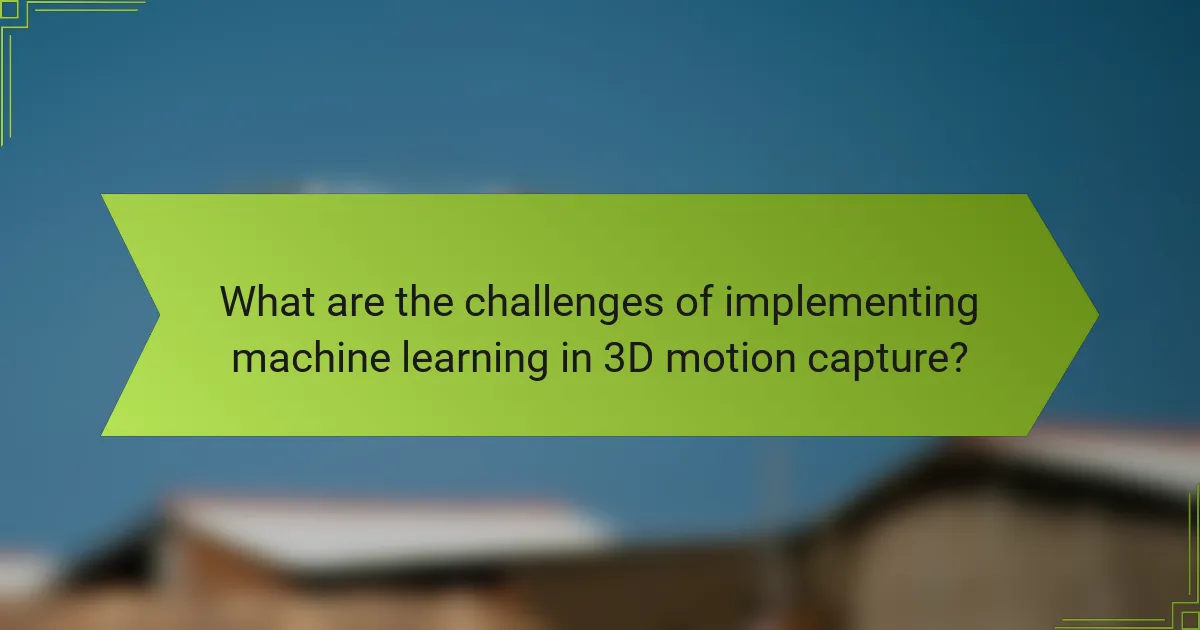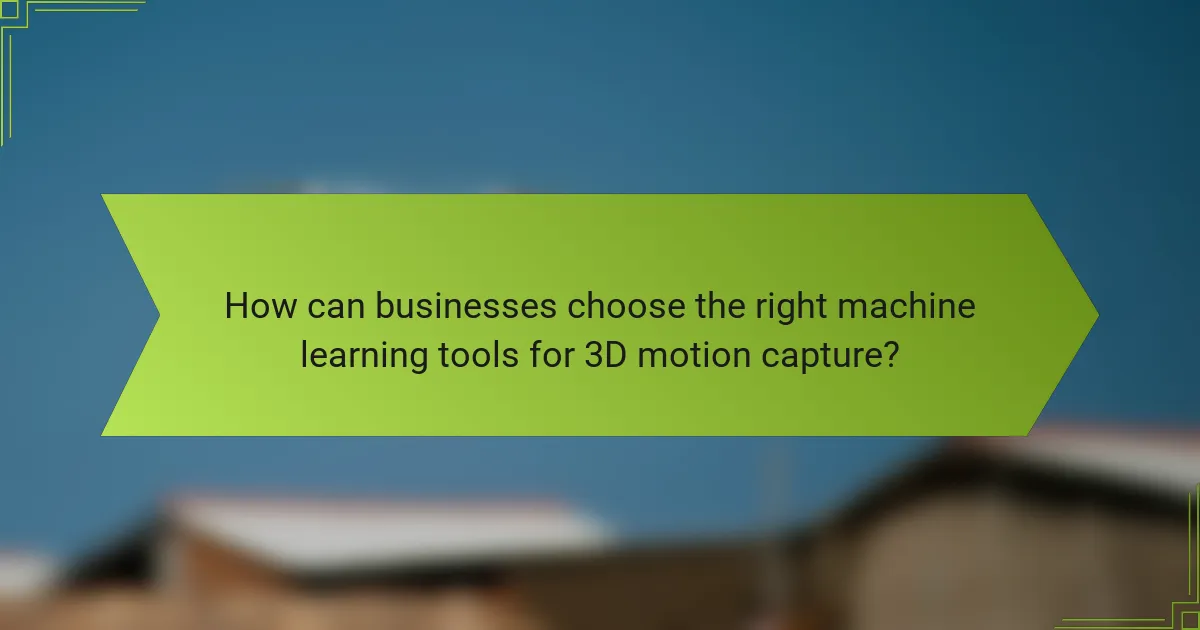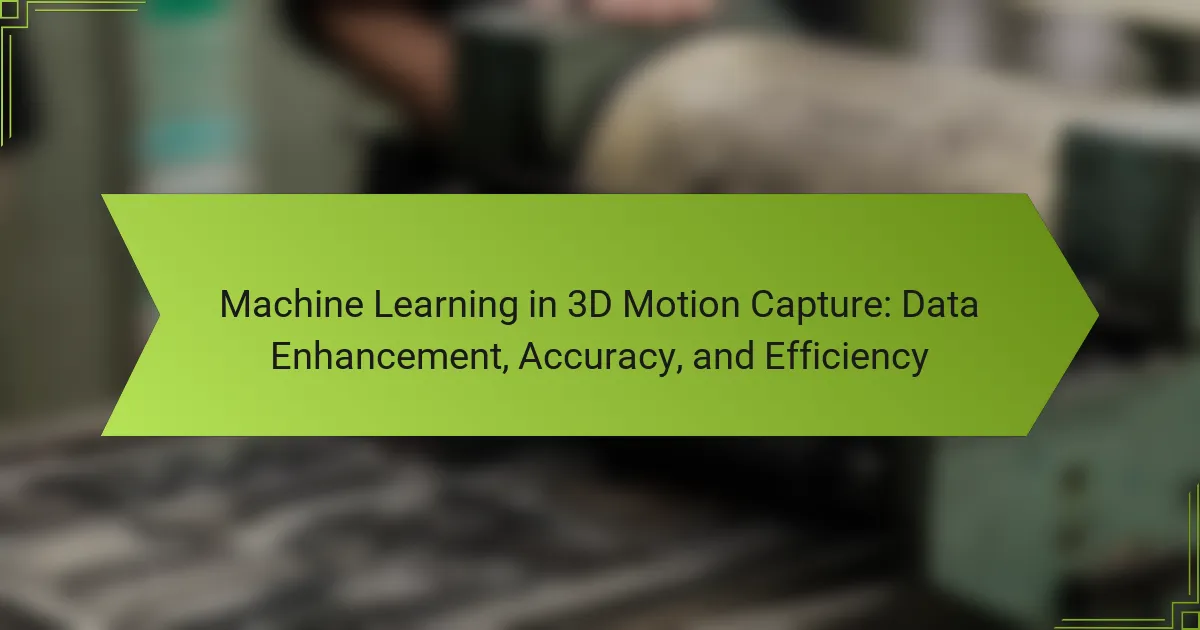Machine learning significantly enhances 3D motion capture by improving data accuracy, reducing noise, and enabling real-time processing. These advancements result in more reliable motion analysis across various fields, including animation, biomechanics, gaming, and sports. Utilizing algorithms such as Convolutional Neural Networks and Recurrent Neural Networks, the efficiency and effectiveness of motion tracking are greatly increased, leading to a superior user experience.

How does machine learning enhance 3D motion capture data?
Machine learning enhances 3D motion capture data by improving the accuracy of motion tracking, reducing noise in the data, and enabling real-time processing capabilities. These advancements lead to more reliable and efficient motion analysis in various applications, from animation to biomechanics.
Improved data accuracy
Machine learning algorithms can significantly boost the accuracy of 3D motion capture by learning from vast datasets and identifying patterns that traditional methods might miss. For instance, deep learning models can analyze motion sequences to correct tracking errors caused by occlusions or sensor limitations.
In practical terms, using machine learning can lead to accuracy improvements of 20-30% in motion tracking, depending on the complexity of the movements and the quality of the training data. This is particularly beneficial in fields like sports science and medical rehabilitation, where precise motion analysis is critical.
Noise reduction techniques
Noise in motion capture data can arise from various sources, such as environmental interference or sensor inaccuracies. Machine learning techniques, such as filtering algorithms and regression models, can effectively reduce this noise by distinguishing between genuine motion signals and irrelevant data.
Common noise reduction methods include Kalman filters and convolutional neural networks, which can smooth out data without losing essential details. Implementing these techniques can lead to cleaner datasets, making it easier to analyze and interpret motion patterns.
Real-time processing capabilities
Machine learning enables real-time processing of 3D motion capture data, allowing for immediate feedback and analysis. This is particularly useful in live performances, sports training, and virtual reality applications, where instant data interpretation is crucial.
Techniques such as edge computing can facilitate low-latency processing, ensuring that motion data is analyzed within milliseconds. This capability enhances user experience and opens up new possibilities for interactive applications, making motion capture more dynamic and responsive.

What are the key benefits of using machine learning in 3D motion capture?
Machine learning enhances 3D motion capture by improving data accuracy, increasing efficiency, and reducing costs. These benefits lead to more reliable motion analysis and a better overall experience for users in fields like gaming, film, and sports.
Increased efficiency
Machine learning algorithms can process large volumes of motion capture data quickly, significantly reducing the time required for analysis. For instance, traditional methods may take hours to interpret data, while machine learning can streamline this to minutes or even seconds.
By automating routine tasks such as data cleaning and feature extraction, machine learning allows professionals to focus on more complex aspects of motion analysis. This shift not only speeds up workflows but also enhances productivity across projects.
Cost reduction
Implementing machine learning in 3D motion capture can lead to substantial cost savings. By minimizing the need for extensive manual labor and reducing the time spent on data processing, organizations can allocate resources more effectively.
Additionally, the improved accuracy from machine learning reduces the likelihood of costly errors in motion capture projects. This reliability can save companies from expensive rework and ensure that budgets are adhered to more closely.
Enhanced user experience
The integration of machine learning into 3D motion capture systems results in a more intuitive user experience. Users benefit from faster data processing and more accurate results, which can enhance the quality of the final product, whether it’s in gaming, animation, or biomechanics.
Furthermore, machine learning can enable real-time feedback during motion capture sessions, allowing users to make immediate adjustments. This capability not only improves the quality of the captured data but also fosters a more engaging and interactive environment for creators and performers alike.

Which machine learning algorithms are most effective for 3D motion capture?
Convolutional Neural Networks (CNNs), Recurrent Neural Networks (RNNs), and Support Vector Machines (SVMs) are among the most effective machine learning algorithms for enhancing 3D motion capture data. Each algorithm has unique strengths that can improve accuracy and efficiency in processing motion data.
Convolutional Neural Networks (CNNs)
CNNs are particularly effective for analyzing spatial data, making them suitable for 3D motion capture applications. They excel at recognizing patterns in visual data, which can help in interpreting complex motion sequences captured by cameras.
When using CNNs, it is crucial to preprocess the motion data to ensure that it is in a format that the network can efficiently process. This often involves normalizing the data and augmenting it to improve the model’s robustness. For instance, applying transformations like rotation or scaling can enhance the training dataset.
Recurrent Neural Networks (RNNs)
RNNs are designed to handle sequential data, making them ideal for 3D motion capture where time-series data is prevalent. They can remember previous inputs, which helps in predicting future motion states based on past movements.
When implementing RNNs, consider using Long Short-Term Memory (LSTM) networks, which are a type of RNN that can better capture long-range dependencies in motion data. This is particularly useful for applications like gesture recognition, where the context of previous movements significantly influences the interpretation of current actions.
Support Vector Machines (SVMs)
SVMs are effective for classification tasks in 3D motion capture, particularly when distinguishing between different types of movements. They work by finding the optimal hyperplane that separates different classes of data points, which can be beneficial for recognizing specific actions.
To use SVMs effectively, ensure that the feature set is well-defined and representative of the motion data. Techniques such as feature scaling and kernel trick can improve SVM performance. However, SVMs may struggle with large datasets, so consider using them for smaller, well-defined problems within the broader motion capture project.

What are the challenges of implementing machine learning in 3D motion capture?
Implementing machine learning in 3D motion capture presents several challenges, including data quality issues, high computational resource demands, and difficulties in integrating with existing systems. Addressing these obstacles is crucial for enhancing the accuracy and efficiency of motion capture technologies.
Data quality issues
Data quality is a critical challenge in 3D motion capture, as inaccurate or incomplete data can lead to poor model performance. Factors such as noise, occlusions, and variations in lighting can degrade the quality of motion capture data. Ensuring high-quality data collection through controlled environments and robust sensors is essential.
To mitigate data quality issues, consider implementing preprocessing techniques such as filtering and normalization. Regularly validating the captured data against known standards can help identify anomalies and improve overall data integrity.
Computational resource demands
Machine learning algorithms for 3D motion capture often require significant computational resources, including powerful GPUs and extensive memory. The complexity of processing large datasets can lead to long training times and increased costs, particularly for real-time applications.
To optimize resource usage, consider using cloud computing services that provide scalable resources on demand. Additionally, employing model optimization techniques, such as pruning and quantization, can reduce the computational burden while maintaining accuracy.
Integration with existing systems
Integrating machine learning solutions with existing 3D motion capture systems can be challenging due to compatibility issues and varying data formats. Legacy systems may not support modern machine learning frameworks, complicating the implementation process.
To facilitate integration, it is advisable to adopt open standards and APIs that promote interoperability. Conducting thorough compatibility assessments before implementation can help identify potential integration hurdles and streamline the transition to machine learning-enhanced systems.

How can businesses choose the right machine learning tools for 3D motion capture?
Businesses can choose the right machine learning tools for 3D motion capture by assessing their specific needs, evaluating software capabilities, and considering total costs. Key factors include the software’s accuracy, ease of integration, and the level of support provided by vendors.
Evaluation criteria for software
When evaluating software for 3D motion capture, consider criteria such as accuracy, processing speed, and compatibility with existing systems. Look for tools that offer robust data enhancement features and real-time analysis capabilities.
Additionally, assess user-friendliness and the software’s ability to scale with your business needs. Conducting trials or demos can provide insight into how well the software meets your requirements.
Cost considerations
Cost is a crucial factor when selecting machine learning tools for 3D motion capture. Prices can vary widely, ranging from a few hundred to several thousand USD depending on features and vendor reputation. Be sure to factor in both upfront costs and ongoing expenses such as subscriptions or maintenance fees.
Consider the potential return on investment (ROI) by evaluating how the software can enhance productivity and accuracy in your projects. A higher initial investment may be justified if the tool significantly improves efficiency or reduces errors.
Vendor support and community
Reliable vendor support is essential for effective use of machine learning tools in 3D motion capture. Look for vendors that provide comprehensive training, documentation, and responsive customer service. A strong support network can help resolve issues quickly and minimize downtime.
Additionally, consider the size and activity of the user community surrounding the software. An active community can offer valuable resources, such as forums for troubleshooting and sharing best practices, which can enhance your overall experience with the tool.
